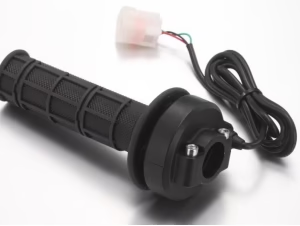Rear Brake Assembly
$100.00
Applications of Rear Brake Assemblies
- Automobiles: Cars and trucks depend on robust rear brakes for balanced stopping power.
- Motorcycles: Essential for controlling speed and ensuring rider safety.
- Electric Scooters: Provide efficient braking, often coupled with regenerative features. Electric scooter rear brakes
- Bicycles: High-end bikes use rear disc brakes for enhanced performance.
Rear Brake Assembly
All You Need to Know About Rear Brake Assembly
The rear brake assembly is a crucial component in any vehicle, playing a vital role in ensuring safety and optimal performance. Whether you’re driving a car, riding a motorcycle, or operating an electric scooter, the rear brake system provides reliable stopping power and stability during deceleration. This article delves into the features, benefits, and maintenance of rear brake assemblies to help you understand their importance and functionality.
What is a Rear Brake Assembly?
A rear brake assembly refers to the complete system of parts located at the rear wheels of a vehicle, designed to slow down or stop its motion. It typically includes components such as:
- Brake Pads: These create friction against the brake rotor to slow the vehicle.
- Brake Rotor/Drum: The surface against which the brake pads press to generate stopping power.
- Calipers: These house the brake pads and apply pressure to the rotor.
- Hydraulic Lines: Channels that deliver brake fluid to enable the braking mechanism.
- Parking Brake Mechanism: An additional feature for securing the vehicle when stationary.
Types of Rear Brake Assemblies
- Disc Brake Assemblies
- Common in modern vehicles, these consist of brake pads and a rotor.
- Offer superior stopping power and heat dissipation.
- Drum Brake Assemblies
- Found in older or budget-friendly vehicles.
- Utilize brake shoes pressing against a drum to create friction.
- Electric Brake Assemblies
- Common in electric vehicles and scooters. Motorcycle rear brake assembly
- Feature regenerative braking to recharge the battery while slowing down.
Benefits of a High-Quality Rear Brake Assembly
- Enhanced Safety
- Provides reliable stopping power, reducing the risk of accidents.
- Improved Vehicle Control
- Ensures stability during sudden stops or on slippery surfaces.
- Longevity of Other Components
- A well-maintained brake system prevents excessive wear on tires and suspension.
- Better Performance
- Ensures smooth and consistent braking, enhancing overall driving experience.
Signs Your Rear Brake Assembly Needs Attention
- Squealing or Grinding Noises: Indicates worn-out brake pads.
- Reduced Responsiveness: May signal brake fluid leaks or air in hydraulic lines.
- Vibrations During Braking: Could be due to warped rotors or drums.
- Brake Warning Light: A clear indicator of a potential issue.
Maintenance Tips for Rear Brake Assembly
- Regular Inspections: Check the condition of brake pads, rotors, and hydraulic lines.
- Replace Worn-Out Components: Ensure timely replacement of pads and rotors to maintain efficiency.
- Monitor Brake Fluid Levels: Low or contaminated fluid can affect braking performance.
- Clean and Lubricate: Keep components free of dust and rust, and ensure proper lubrication.
- Professional Servicing: Schedule periodic check-ups with a trusted mechanic.
Why Choose a Quality Rear Brake Assembly?
Investing in a high-quality rear brake assembly ensures peace of mind, safety, and performance. Reliable braking systems not only protect you and your passengers but also reduce long-term maintenance costs. Whether you’re upgrading your current setup or replacing worn-out parts, choosing the right brake assembly is essential.
Conclusion
The rear brake assembly is a critical component that directly impacts your vehicle’s safety and performance. Understanding its features, maintenance requirements, and applications can help you make informed decisions about repairs and replacements. By prioritizing a reliable and high-quality brake system, you’re ensuring a safer and smoother ride for years to come. Buy rear brake assembly online
Be the first to review “Rear Brake Assembly” Cancel reply
Related products
Electrical
eride pro ss parts
Electrical
Electrical
Electrical
Electrical
Electrical













Reviews
There are no reviews yet.